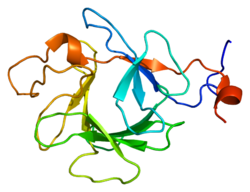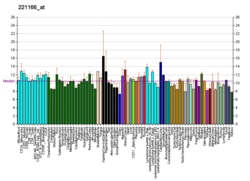Facteur 23 de croissance du fibroblaste
| FGF23 | |||||||||||||||||||||||||||||||||||||||||||||||||||
|---|---|---|---|---|---|---|---|---|---|---|---|---|---|---|---|---|---|---|---|---|---|---|---|---|---|---|---|---|---|---|---|---|---|---|---|---|---|---|---|---|---|---|---|---|---|---|---|---|---|---|---|
 | |||||||||||||||||||||||||||||||||||||||||||||||||||
| |||||||||||||||||||||||||||||||||||||||||||||||||||
| Identifiants | |||||||||||||||||||||||||||||||||||||||||||||||||||
| Aliases | FGF23 | ||||||||||||||||||||||||||||||||||||||||||||||||||
| IDs externes | OMIM: 605380 MGI: 1891427 HomoloGene: 10771 GeneCards: FGF23 | ||||||||||||||||||||||||||||||||||||||||||||||||||
| |||||||||||||||||||||||||||||||||||||||||||||||||||
| |||||||||||||||||||||||||||||||||||||||||||||||||||
| |||||||||||||||||||||||||||||||||||||||||||||||||||
| |||||||||||||||||||||||||||||||||||||||||||||||||||
| |||||||||||||||||||||||||||||||||||||||||||||||||||
| Wikidata | |||||||||||||||||||||||||||||||||||||||||||||||||||
| |||||||||||||||||||||||||||||||||||||||||||||||||||
FGF23 est une protéine appartenant à la famille des facteurs de croissances des fibroblastes (« fibroblast growth factor 23 »). Son gène est FGF23 situé sur le chromosome 12 humain.
Rôles
Il est exprimé dans les ostéocytes. Il diminue l'expression de plusieurs enzymes intervenant dans la synthèse de la vitamine D[5] , il est très précocement augmenté lorsque les taux sanguins de phosphates[6] sont élevés. Il diminue la réabsorption des phosphates urinaires par le rein[7].
Il pourrait avoir un rôle dans la constitution d'une hypertrophie ventriculaire gauche[8], possiblement par le biais d'une augmentation du calcium intra-cellulaire[9]. Cet effet semble cependant faible[10].
En médecine
Son taux est abaissé dans plusieurs maladies comportant une hypophosphatémie dont l'hypophosphatémie liée au chromosome X, l'ostéomalacie tumorale et la dysplasie fibreuse[11].
Son taux peut être augmenté en cas d'hyperphosphatémie, avec augmentation de la synthèse de la vitamine D, calcifications du tissu mou et hyperostose[12].
Le burosumab est un anticorps monoclonal dirigé contre le FGF23 testé dans l'hypophosphatémie liée au chromosome X[13].
Utilisation en tant que marqueur de risque
La concentration sanguine en FGF23 augmente en cas d'insuffisance rénale[6] et son taux est corrélé avec la masse du ventricule gauche cardiaque[14],[15]. Il semble être un marqueur de risque de mortalité chez les patients en insuffisance rénale chronique dialysée[16] et de risque d'aggravation de l'insuffisance rénale chez les patients porteur d'une insuffisance rénale modérée[17].
Chez le patient coronarien, un taux élevé semble être corrélé avec un plus grand risque de survenue de maladies cardio-vasculaires et de mortalité[18].
Chez le tout-venant, il semble être un marqueur de risque de dysfonction cardiaque et de survenue de fibrillation auriculaire[19],[20].
Notes et références
- ↑ a b et c GRCh38: Ensembl release 89: ENSG00000118972 - Ensembl, May 2017
- ↑ a b et c GRCm38: Ensembl release 89: ENSMUSG00000000182 - Ensembl, May 2017
- ↑ « Publications PubMed pour l'Homme », sur National Center for Biotechnology Information, U.S. National Library of Medicine
- ↑ « Publications PubMed pour la Souris », sur National Center for Biotechnology Information, U.S. National Library of Medicine
- ↑ (en) Shimada T, Hasegawa H, Yamazaki Y. et al. « FGF‐23 is a potent regulator of vitamin D metabolism and phosphate homeostasis » J Bone Miner Res. 2004;19:429-35. PMID 15040831
- ↑ a et b (en) Larsson T, Nisbeth U, Ljunggren O, Juppner H, Jonsson KB. « Circulating concentration of FGF‐23 increases as renal function declines in patients with chronic kidney disease, but does not change in response to variation in phosphate intake in healthy volunteers » Kidney Int. 2003;64:2272-9. PMID 14633152
- ↑ (en) Gattineni J, Bates C, Twombley K. et al. « FGF23 decreases renal NaPi-2a and NaPi-2c expression and induces hypophosphatemia in vivo predominantly via FGF receptor 1 » Am J Physiol Renal Physiol. 2009;297:F282–F291. PMID 19515808
- ↑ (en) Faul C, Amaral AP, Oskouei B. et al. « FGF23 induces left ventricular hypertrophy » J Clin Invest. 2011;121:4393-408. PMID 21985788
- ↑ (en) Touchberry CD, Green TM, Tchikrizov V. et al. FGF23 is a novel regulator of intracellular calcium and cardiac contractility in addition to cardiac hypertrophy Am J Physiol Endocrinol Metab. 2013;304:E863. PMID 23443925
- ↑ (en) Agarwal I, Ide N, Ix JH. et al. « Fibroblast Growth Factor–23 and cardiac structure and function » J Am Heart Assoc. 2014;3:e000584. PMID 24525546
- ↑ (en) Imel EA, Econs MJ. « Fibroblast growth factor 23: roles in health and disease » J Am Soc Nephrol. 2005;16:2565–75. PMID 16033853
- ↑ (en) Liu S, Quarles LD. « How fibroblast growth factor 23 works » J Am Soc Nephrol. 2007;18:1637–47. PMID 17494882
- ↑ Carpenter TO, Whyte MP, Imel EA et al. Burosumab therapy in children with X-linked hypophosphatemia, N Engl J Med, 2018;378:1987-1998
- ↑ (en)Gutierrez OM, Januzzi JL, Isakova T. et al. « Fibroblast growth factor 23 and left ventricular hypertrophy in chronic kidney disease » Circulation 2009;119:2545-52. PMID 19414634
- ↑ (en) Mirza MA, Larsson A, Melhus H, Lind L, Larsson TE. « Serum intact FGF23 associate with left ventricular mass, hypertrophy and geometry in an elderly population » Atherosclerosis 2009;207:546-51. PMID 19524924
- ↑ (en) Gutierrez OM, Mannstadt M, Isakova T. et al. « Fibroblast growth factor 23 and mortality among patients undergoing hemodialysis » N Engl J Med. 2008;359:584-92. PMID 18687639
- ↑ (en) Isakova T, Xie H, Yang W. et al. « Fibroblast growth factor 23 and risks of mortality and end‐stage renal disease in patients with chronic kidney disease » JAMA 2011;305:2432-9. PMID 21673295
- ↑ (en) Parker BD, Schurgers LJ, Brandenburg VM. et al. « The associations of fibroblast growth factor 23 and uncarboxylated matrix Gla protein with mortality in coronary artery disease: the Heart and Soul Study » Ann Intern Med. 2010;152:640-8. PMID 20479029
- ↑ (en) Seiler S, Cremers B, Rebling NM. et al. « The phosphatonin fibroblast growth factor 23 links calcium‐phosphate metabolism with left‐ventricular dysfunction and atrial fibrillation » Eur Heart J. 2011;32:2688-96. PMID 21733911
- ↑ Mathew JS, Sachs MC, Patton KK et al. Fibroblast growth factor-23 and incident atrial fibrillation: the Multi-Ethnic Study of Atherosclerosis (MESA) and the Cardiovascular Health Study (CHS), Circulation, 2014;130:298–307
Voir aussi
 Portail de la biologie cellulaire et moléculaire
Portail de la biologie cellulaire et moléculaire  Portail de la médecine
Portail de la médecine

















